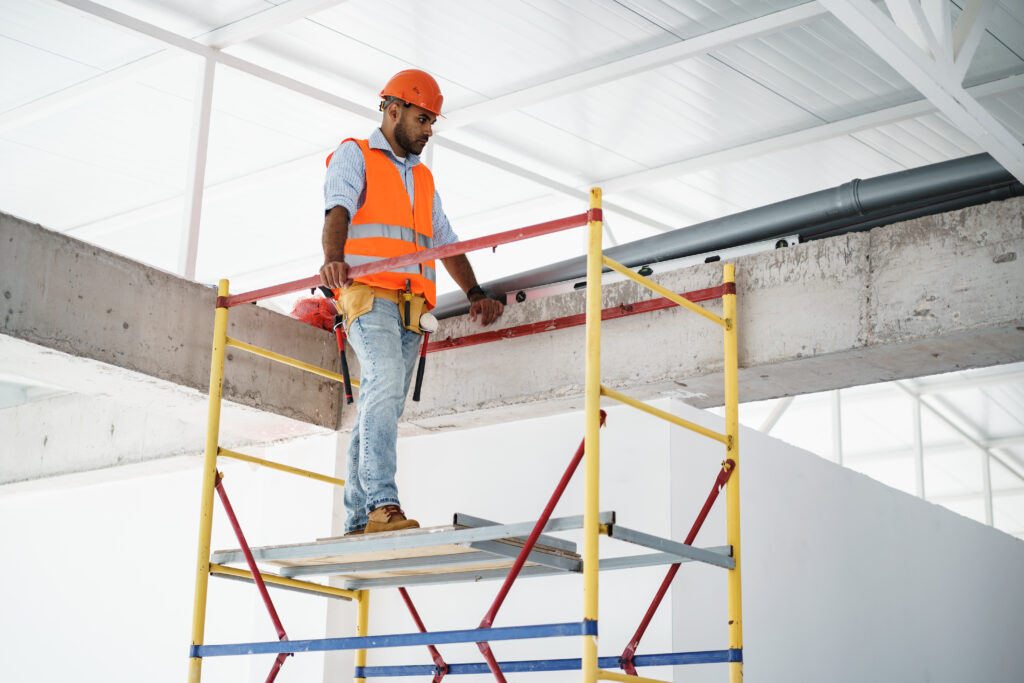Construction activities occur every day and everywhere from excavation to finishing. Professional workers, support tools, and heavy machinery are combined to build our large buildings, homes, bridges, and so much more. Scaffolding is a tool that allows the associate to perform work on upper levels on the inside and outside of buildings, providing working leverage to properly complete assigned task safely for construction workers. Producing quality work, and maintaining associate safety is a twofold function needed to fulfill all successful task. If the associate can build with quality, but is involved in an accident while doing it, this process application is a failure. Unfortunately, 80 deaths occur annually due to scaffolding accidents Scaffold Injuries per year on construction sites.
Construction leaders are faced with a critical question- how do they keep their workforce safe on the scaffolds while they effectively build said projects on time? The answer is not simple as construction has evolved over time and requires a continuous scrutiny of work procedures, process applications, associate competence, and more. Added to this list are the external factors like new Occupational Safety and Health Administration (OSHA) regulations, building material changes, architect building design changes to name a few. Therefore, construction leaders must stay current with the latest safety updates and regulations to be proactive in their approach to workforce safety to effectively build and meet timely deadlines.
At FPIS, we advise organization on Awareness of why safety problems exist; provide recommended Safety countermeasures to reduce or eliminate accidents; present Evidence that should keep their workforce safe; and prevent liability to the organization where it concerns scaffolding.
Awareness
- Incorrectly built scaffolds have caused collapses and associate falls. Associates were not trained correctly to build the scaffold due to possible missed locking at the attaching points, leading to these types of accidents
- When associates do not understand the weight capacity of the scaffold, they overload the scaffold with tools and materials, causing collapse, and/or material droppage
- Improper scaffold surfaces can contribute to associate slip and falls, for example, due to wet conditions
- Protecting the work environment around the scaffold is important to keeping the proper spacing to protect pedestrians from falling parts, tools, etc.…
- Cutting corners impacts when the associate is off task and misses a critical step in the entire scaffolding build and or usage process
- Manufacturer’s liability (verify per State) can be proved that the scaffold accident was allegedly caused by a flaw in the Manufacturer’s design, enabling the associate to sue them- Employee and Scaffolding
Safety
- Training on constructing scaffolds is required per OSHA OSHA-About Scaffolding and Employee and Scaffolding .
- Training must cover the following:
- Proper assembly
- Controlled work instruction. It spells out the details to build the scaffold with safety as an emphasis in the process
- Proper disassembly
- Just as important as the assembly process, checks for worn parts and replacements are necessary
- Moving technique – from one spot to another
- Scaffold maintenance – what – when – how to service
- Job Hazard Analysis (JHA) for the scaffold being used. Use this document on site to ensure all associates have the hazards and avoidance measures in their mind at the point of using the scaffold
- Jobs that are 10 feet and higher require guardrails and or the appropriate fall protection in place
- Attendance kept on file for all who were trained
- Appoint and train a person (s) to be the Subject Matter Expert (SME) – they will do the following:
- Scaffolding hazards identification and sharing
- Examine the parts of the scaffold to validate functionality
- Tag (Red), remove out of service (if necessary), and keep active records
- Audit scaffold inventory and document findings
- Understand and follow the regulations of the State where the scaffold will be in use
- Track near misses and use as a formal means to improve the scaffolding process and training the associates
- Any accident will be carefully studied to understand the root cause and determine the countermeasure to prevent it from recurring.
Evidence
- The following will be in place to show there is an anchored scaffold safety program in place:
- An active-controlled Training Program in place for audit and improvement reasons. The training frequency for associates will be done per OSHA requirements and or the Organization’s policies
- An active Near Miss program captures near misses and keep associates sensitive and involved in solving problems that can lead to potential accidents
- JHA’s will be controlled document that will be used by the SME before the associates use a scaffold. They will sign off that they understood the JHA.
- A designated place identified for tagged (Red), out of service scaffolds (to be repaired, destroyed, or cannibalized for parts). Want to ensure there is no mix up between serviceable and non-serviceable scaffolds
Conclusion
No problem exists without a solution. FPIS understands the urgency of cultivating and sustaining a safety culture that will keep your workforce safe and protect your organization against liabilities cause by scaffold accidents. Make us your Go-to resource to empower you to champion this effort as we will provide you with on time solutions. For more information, reach out to FPIS to learn how we can partner with you in your efforts, www.fpisinv.com
References
1] Law offices of Mark C. Blane, APC, “What are some statistics regarding scaffolding accidents occurring on job or construction sites”. Mark Blane Website. 2022. Scaffold Injuries per year
2] Grainger Know How, “OSHA Scaffolding Requirements for Construction and General Industry”. Grainger Website. 1/1/20. OSHA-About Scaffolding
3] Hill and Associates, “Who is legally responsible for Scaffold accidents?”. Hill Justice Website. Employee and Scaffolding






